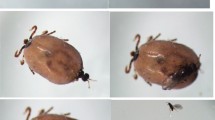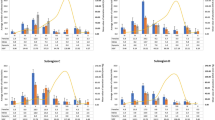Abstract
AN interesting example of the necessity for co-operation in the solution of complex problems of tick bionomics was recently brought to my notice by Dr. V. G. L. Van Someren of Nairobi and concerns infestation of the nostrils of man by the immature nymph stage of a tick belonging to the genus Amblyomma. These nymphs are white and were removed from the nostrils of three different persons, namely, Mr. D. Van Someren, Dr. V. G. L. Van Someren and Mr. T. H. E. Jackson, during visits to the depths of primary tropical rain forest in Uganda. The two former-mentioned persons were infested while in the Budongo Forest of Bunyoro during July 1952 ; the two latter while in the Kayonza Forest of Kigezi (known also as the Impenetrable Forest) during May and June 1957. A single example of the same tick was also found by Dr. Van Someren as it crawled up his neck when in the Kibali Forest of Toro.
This is a preview of subscription content, access via your institution
Access options
Subscribe to this journal
Receive 51 print issues and online access
$199.00 per year
only $3.90 per issue
Buy this article
- Purchase on Springer Link
- Instant access to full article PDF
Prices may be subject to local taxes which are calculated during checkout
Similar content being viewed by others
References
Robinson, L. E., “The Genus Amblyomma”, Vol. 4 in Nuttall et al., “Ticks. A Monograph of the Ixodoidea”, 302 (Cambridge Univ. Press).
Author information
Authors and Affiliations
Rights and permissions
About this article
Cite this article
WALTON, G. A Tick infesting the Nostrils of Man. Nature 188, 1131–1132 (1960). https://doi.org/10.1038/1881131a0
Issue Date:
DOI: https://doi.org/10.1038/1881131a0
This article is cited by
-
Survey of ticks and tick-borne pathogens in wild chimpanzee habitat in Western Uganda
Parasites & Vectors (2023)
Comments
By submitting a comment you agree to abide by our Terms and Community Guidelines. If you find something abusive or that does not comply with our terms or guidelines please flag it as inappropriate.



